Architecture Home Styles
How Often Do Roofs Need to Be Reshingled?
Journey through the lifespan of your roof as we unravel the mystery behind how often roofs need to be reshingled…

When it comes to maintaining our homes, our roofs serve as our shields against the elements, akin to a steadfast guardian watching over us.
But how often should we consider giving our roofs a fresh set of armor? The answer lies in a delicate balance of factors that dictate the lifespan of our shingles.
Let's explore the intricacies of reshingling frequencies and uncover the secrets to maximizing our roof's longevity.
Key Takeaways
- Roof reshingling frequency varies based on material type and climate exposure.
- Signs like curling shingles or granules in gutters indicate the need for reshingling.
- Regular inspections and maintenance can extend the lifespan of a roof.
- Proper ventilation, insulation, and quality installation impact the time between reshingling cycles.
Factors Affecting Reshingling Frequency
When considering the frequency of reshingling roofs, various factors play a crucial role in determining the optimal timing for this maintenance task.
The type of roofing material used greatly influences how often a roof needs reshingling. For instance, asphalt shingle roofs typically require reshingling every 15-30 years, while wood shingle roofs may need it around every 25 years. Metal roofs, on the other hand, can last anywhere from 20 to 50 years before requiring reshingling.
Climate exposure also plays a significant role in the lifespan of roofing materials, impacting the frequency of reshingling. Additionally, maintenance practices and the quality of installation can either prolong or shorten the time between reshingling cycles.
Regular inspections to assess signs of wear, damage, and the overall condition of the roof are crucial in determining when reshingling is necessary, ensuring the longevity and functionality of the roof.
Types of Shingles and Lifespan
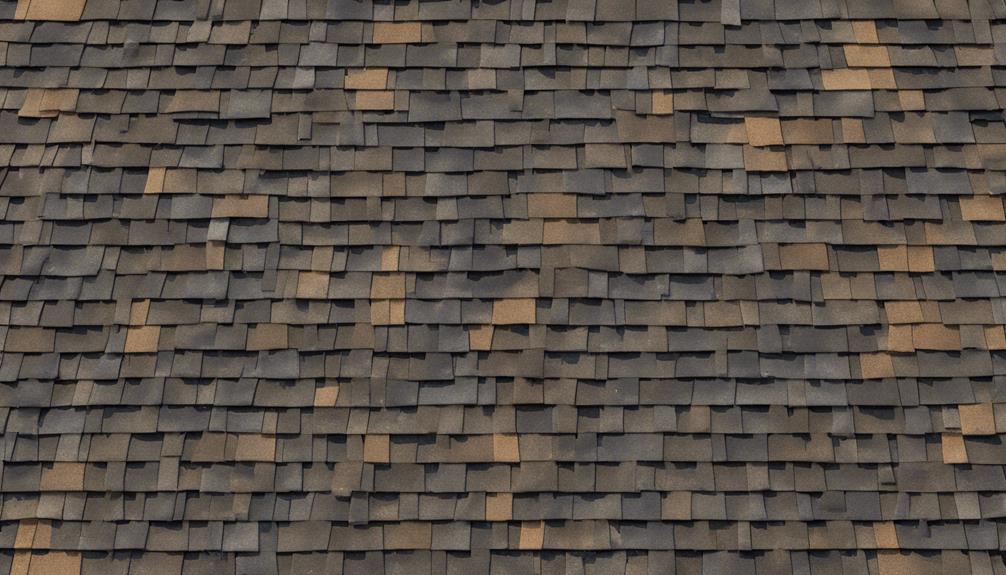
Exploring various types of shingles and their respective lifespans provides valuable insights into the durability and maintenance requirements of different roofing materials.
Here are some key points to consider:
- Asphalt Shingles: Typically need reshingling every 15-30 years, depending on the quality and type of shingles used.
- Wood Shingle Roofs: Require reshingling approximately every 25 years to maintain their integrity and appearance.
- Composite Shingle Roofs: Typically need to be reshingled every 15 years to ensure optimal performance and protection.
- Metal Roofs with Standing Seam Panels: Can last 20-50 years before needing reshingling, offering long-term durability.
Each type of shingle material offers a different balance between longevity and maintenance needs. While asphalt shingles and wood shingles require more frequent reshingling, metal roofs with standing seam panels and slate roofs offer extended lifespans, reducing the frequency of reshingling and providing long-lasting protection.
When selecting roofing materials, considering the lifespan and maintenance requirements can help homeowners make informed decisions to ensure the longevity of their roofs.
Environmental Impact on Roof Longevity
Considering the impact of environmental factors on roof longevity, it becomes evident that severe weather conditions and exposure to extreme elements can significantly affect the lifespan of various roofing materials. Extreme weather events such as hurricanes, hailstorms, and high winds can expedite the deterioration of roofs, leading to a more frequent reshingling schedule. Additionally, exposure to intense heat or cold can cause asphalt shingles to degrade faster, necessitating earlier reshingling. Regions with high precipitation or humidity levels may also experience accelerated wear and tear on roofs, requiring more frequent maintenance.
Environmental elements like sunlight exposure, pollution, and tree coverage play crucial roles in the longevity of roofing materials, influencing the timing of reshingling projects. Proper ventilation and insulation in attics can aid in regulating temperature and moisture levels, potentially extending the period between necessary reshingling tasks. By understanding and addressing these environmental impacts, homeowners can better preserve the integrity of their roofs and optimize their longevity.
Signs Indicating Reshingling Is Needed
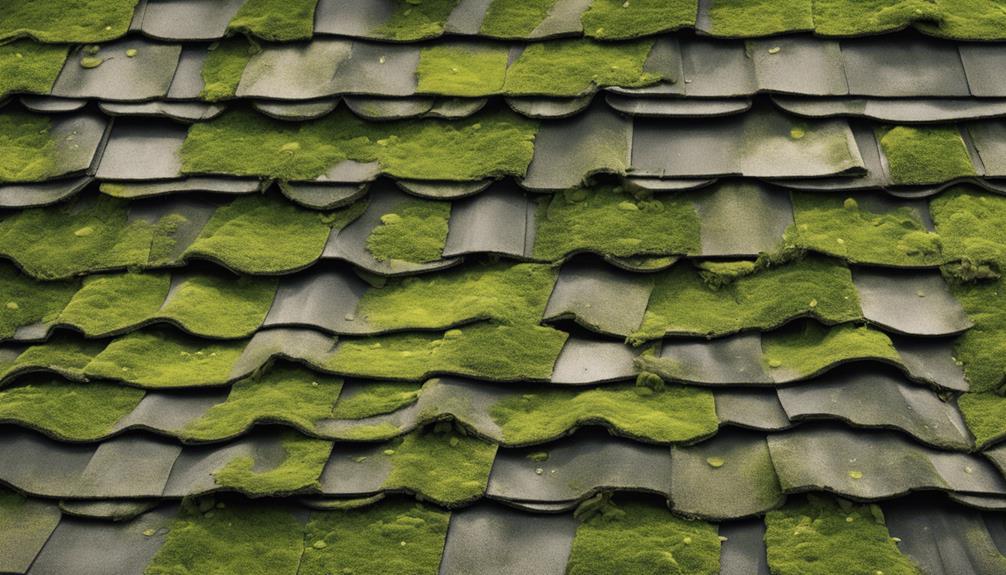
Regularly checking for specific signs on your roof can help determine when reshingling is needed to maintain its integrity and prolong its lifespan. When inspecting your roof, keep an eye out for these key indicators that it may be time to replace the shingles:
- Curling or buckling shingles: These can signal wear and potential water damage.
- Missing shingles or tiles: Gaps in your roof can compromise its effectiveness.
- Granules in gutters: Accumulation of shingle granules may indicate shingle deterioration.
- Damaged or cracked shingles: These are clear signs that your roof needs attention.
Maintenance Tips for Extending Roof Lifespan
To effectively extend the lifespan of your roof, it is crucial to prioritize regular inspections and maintenance tasks. Routine roof inspections help in identifying issues early, allowing for prompt repairs and maintenance that can significantly prolong the life of your roof. Here are some maintenance tips to consider:
| Maintenance Task | Importance |
|---|---|
| Roof Inspection | Regular inspections can catch problems early |
| Ventilation | Proper ventilation prevents mold and damage |
| Shingle Replacement | Promptly replace damaged or missing shingles |
| Flashing Repair | Check and repair flashing to prevent water damage |
Maintaining a consistent maintenance schedule is key to extending your roof's lifespan. By investing time and resources in these maintenance tasks, you can ensure that your roof remains in optimal condition, protecting your home from potential damage. Remember, a well-maintained roof not only enhances the aesthetics of your home but also adds to its longevity.
Frequently Asked Questions
How Often Should You Reshingle Your Roof?
When it comes to reshingling your roof, it's essential to consider the material and maintenance. Regular reshingling can extend the life of your roof and prevent costly damage. Factors like the type of shingles and climate can influence how often you should reshingle.
Our team recommends assessing your roof every 15-30 years for asphalt shingles, 20-25 years for wood shingles, 15 years for composite shingles, and up to 100+ years for slate roofs.
How Do I Know When My Shingles Need Replacing?
When our shingles start curling, buckling, or going AWOL, it's time for a roof makeover. Keep an eye out for shingle granules in the gutters – a telltale sign of shingle wear and tear.
Don't wait for shingles to crack or break; replace them promptly to prevent bigger headaches. While spot treatments can buy some time, materials usually throw in the towel at specific ages.
Stay vigilant to keep your roof in top shape!
How Many Times Can a Roof Be Reshingled?
We can reshingle a roof typically once over existing layers before a full tear-off is necessary. Building codes often allow up to two layers to avoid overwhelming the roof's structure. Repeated reshingling can affect aesthetics and lifespan due to added weight and reduced ventilation.
Each reshingling adds another layer, potentially impacting water shedding. Consult a roofing professional to evaluate if reshingling is suitable based on the roof's condition and local regulations.
How Long Do Shingles Last on a Roof?
Shingles on a roof typically last 15-30 years, depending on the type and quality. It's essential to consider these factors for long-term durability.
Proper maintenance can extend the lifespan of shingles, ensuring your roof remains in top condition. Understanding the longevity of different shingle materials is key to making informed roofing decisions.
We recommend periodic inspections to assess the state of your shingles and plan for replacements when needed.
Conclusion
As we navigate the ever-changing landscape of roof maintenance, it's crucial to remember that our roofs serve as our first line of defense against the elements.
Just like a sturdy roof protects a house, our diligence in reshingling ensures longevity and strength.
Let's continue to tend to our roofs with care, like tending to a garden, nurturing them to withstand any storm that may come our way.
- About the Author
- Latest Posts
Introducing Ron, the home decor aficionado at ByRetreat, whose passion for creating beautiful and inviting spaces is at the heart of his work. With his deep knowledge of home decor and his innate sense of style, Ron brings a wealth of expertise and a keen eye for detail to the ByRetreat team.
Ron’s love for home decor goes beyond aesthetics; he understands that our surroundings play a significant role in our overall well-being and productivity. With this in mind, Ron is dedicated to transforming remote workspaces into havens of comfort, functionality, and beauty.
Architecture Home Styles
What Elements Define Tropical Design Style?
Curious about what elements define tropical design style? Explore how patterns, textures, and colors come together to create a paradise in your home.
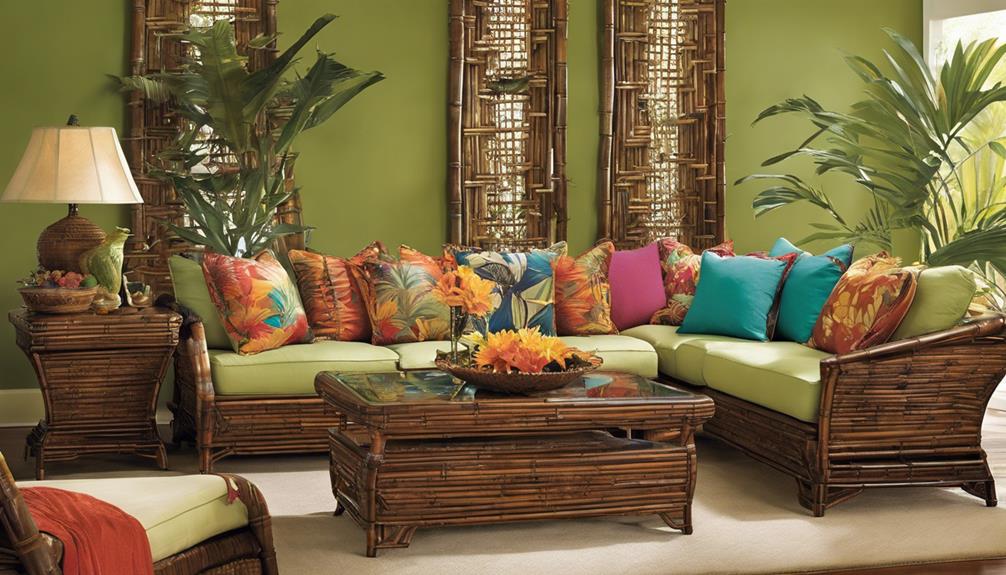
In the world of interior design, the lush greenery and vibrant colors of tropical style symbolize a retreat into nature and relaxation.
But what truly defines this design aesthetic? From patterns and prints to natural textures and materials, tropical design style encompasses a range of elements that evoke a sense of paradise within your home.
Let's explore how each element contributes to creating a space that transports you to a tropical oasis, inviting you to unwind and indulge in the beauty of your surroundings.
Key Takeaways
- Bold patterns and prints like palm motifs bring vibrancy and nature indoors.
- Incorporating greenery fosters tranquility and adds a lush tropical feel.
- Vibrant colors like turquoise and yellow create energizing and visually stimulating spaces.
- Natural textures such as rattan and bamboo enhance the tropical ambiance authentically.
Patterns and Prints
Incorporating bold and vibrant patterns inspired by nature is a key aspect of the tropical design style, instantly infusing spaces with a playful and exotic ambiance. Tropical walls adorned with palm tree motifs or banana leaves bring a touch of the tropics indoors. These natural materials, whether in wallpapers or textiles, add texture and depth to a room, creating a sense of lushness and vitality.
The use of palm prints on cushions or curtains can transport you to a sunny beach or a tropical forest, making you feel connected to nature even when indoors. The intricate details of these patterns mimic the beauty of the outdoors, allowing you to escape to a paradise of your own making. By incorporating these lively designs, you can transform any space into a vibrant tropical oasis, where the energy of nature flows freely. Embracing these bold prints is a sure way to inject life and personality into your home decor.
Greenery and Houseplants

Greenery and houseplants breathe life into tropical design, infusing spaces with lushness and vibrancy. These essential elements bring a touch of nature indoors, creating a tropical oasis. From towering palm trees to the sturdy snake plants, each addition regulates air quality while enhancing the aesthetic appeal. The variety of green plants used in tropical design not only refreshes the atmosphere but also evokes a sense of relaxation akin to tropical environments.
Incorporating houseplants of different sizes and shapes adds depth to the design, amplifying the tropical vibe within the space. The presence of greenery doesn't just contribute to the aesthetics but also fosters tranquility and a deeper connection to nature. The overall ambiance is elevated, making the space feel like a tropical paradise. By strategically placing these plants, one can achieve a harmonious balance between nature and interior design, resulting in a vibrant and inviting tropical setting.
Vibrant Tropical Colors
The lush greenery and houseplants in a tropical design effortlessly lead us into a vibrant world of tropical colors, including turquoise, aqua, green, yellow, and orange. These vibrant colors form the essence of a tropical palette, capturing the natural beauty of tropical environments with their dynamic and lively hues. To showcase the range and impact of these colors, let's explore a table highlighting their significance:
| Tropical Color | Description |
|---|---|
| Turquoise | Evokes the |
| crystal-clear | |
| waters of | |
| tropical beaches | |
| Aqua | Resembles the |
| refreshing | |
| tropical seas | |
| Green | Reflects the |
| lush foliage and | |
| jungles | |
| Yellow | Mimics the |
| bright sunshine | |
| of the tropics | |
| Orange | Symbolizes the |
| warmth and | |
| energy of | |
| tropical climates |
These vibrant tropical colors work harmoniously to create a visually stimulating and energizing tropical design style that transports us to a dynamic and lively oasis.
Natural Textures and Materials
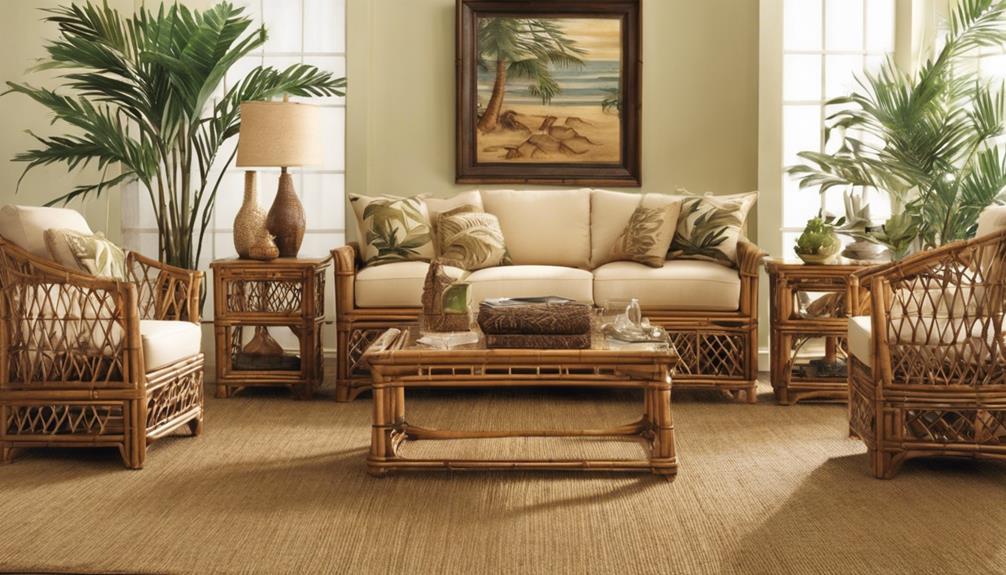
Enhancing the tropical ambiance, natural textures and materials like rattan, bamboo, and wicker infuse an authentic feel into the design space. These elements play a crucial role in creating a modern tropical interior that's both stylish and inviting. Here's how natural textures and materials contribute to the overall tropical design aesthetic:
- Organic Materials: Using materials like jute, seagrass, and teak helps to enhance the tropical vibe, bringing a touch of nature indoors.
- Natural Fibers: Incorporating natural fibers such as linen and cotton adds a light and breezy feel to the space, perfect for capturing the essence of a tropical paradise.
- Earthy Elements: Wood, stone, and water features not only add visual interest but also evoke a sense of the outdoors, promoting a connection with nature.
- Sustainability: Opting for sustainable materials like reclaimed wood and eco-friendly fabrics aligns with the tropical style's emphasis on natural living, promoting fresh air and a tranquil environment within the home.
Light and Airy Spaces
Creating an ambiance that feels light and airy is essential in tropical design style, achieved through strategic use of natural light and ventilation techniques. In tropical interiors, the emphasis is on harnessing the natural elements to create a sense of openness and spaciousness. Light-colored walls and furnishings play a crucial role in reflecting light and enhancing the overall brightness of the space. To maximize natural light, large windows, skylights, and glass doors are commonly incorporated, blurring the boundaries between indoor and outdoor areas. Additionally, light, sheer curtains or blinds are utilized to allow sunlight to filter through while maintaining privacy.
The use of lightweight fabrics, open shelving, and minimalistic furniture further contributes to the light and airy feel of tropical design style. These elements not only promote a breezy atmosphere but also evoke a sense of tranquility and relaxation. By embracing natural light and ventilation, tropical interiors create a welcoming and refreshing environment that invites a connection with the outdoors.
Frequently Asked Questions
What Are the Elements of Tropical Style?
When we think about tropical style, certain elements immediately come to mind. From vibrant colors that exude warmth to materials like wicker and rattan that invite a sense of relaxation, tropical design is all about blending indoors with the outdoors seamlessly.
Elements such as natural fabrics, pitched roofs for rain protection, and a focus on light and water all play a crucial role in defining this style that brings a touch of paradise into your home.
How to Design a Tropical Style?
When designing a tropical style, we focus on creating a lush and vibrant ambiance. Infusing bold patterns, green leaves, and natural textures is essential.
To achieve this, we incorporate elements like houseplants, rattan furniture, and colorful prints. By embracing the beauty of nature and incorporating personal style into decor choices, we can bring the tropical paradise indoors.
Let's transform our space into a relaxing oasis with vibrant hues and natural elements.
What Is Tropics Style?
When it comes to tropical style, we're talking about a design aesthetic inspired by the vibrant elements of nature like weather, sun, and water.
This style often blurs the lines between indoor and outdoor spaces, bringing in elements like pitched roofs and palapas for a seamless transition.
Think wicker, rattan, and natural fabrics like linen and cotton to create that laid-back, island vibe that defines tropical design.
What Materials Are Used in Tropical Interior Design?
When designing with a tropical vibe, we gravitate towards natural materials like wicker, bamboo, and teak to evoke that lush paradise feel. These elements infuse our spaces with warmth and relaxation.
Fabrics like linen and cotton enhance the airy ambiance, while seagrass rugs and sisal carpets bring in texture and earthy charm.
Plantation shutters made of wood or bamboo not only add a tropical touch but also allow us to control the light effortlessly.
Conclusion
In conclusion, the tropical design style brings a touch of paradise into your home with its vibrant colors, lush greenery, and natural textures.
Imagine lounging on a wicker chair surrounded by tropical prints and houseplants, basking in the warm glow of natural light.
The soothing ambiance created by these elements will transport you to a tropical oasis, where relaxation and creativity thrive.
Embrace the tropical design style to infuse your space with a sense of tranquility and exotic charm.
- About the Author
- Latest Posts
Introducing Ron, the home decor aficionado at ByRetreat, whose passion for creating beautiful and inviting spaces is at the heart of his work. With his deep knowledge of home decor and his innate sense of style, Ron brings a wealth of expertise and a keen eye for detail to the ByRetreat team.
Ron’s love for home decor goes beyond aesthetics; he understands that our surroundings play a significant role in our overall well-being and productivity. With this in mind, Ron is dedicated to transforming remote workspaces into havens of comfort, functionality, and beauty.
Architecture Home Styles
What Is the Difference Between Modern and Mid-Century Modern Design?
Only subtle distinctions separate modern and mid-century modern design, enticing readers to uncover the nuanced differences in these popular interior styles.
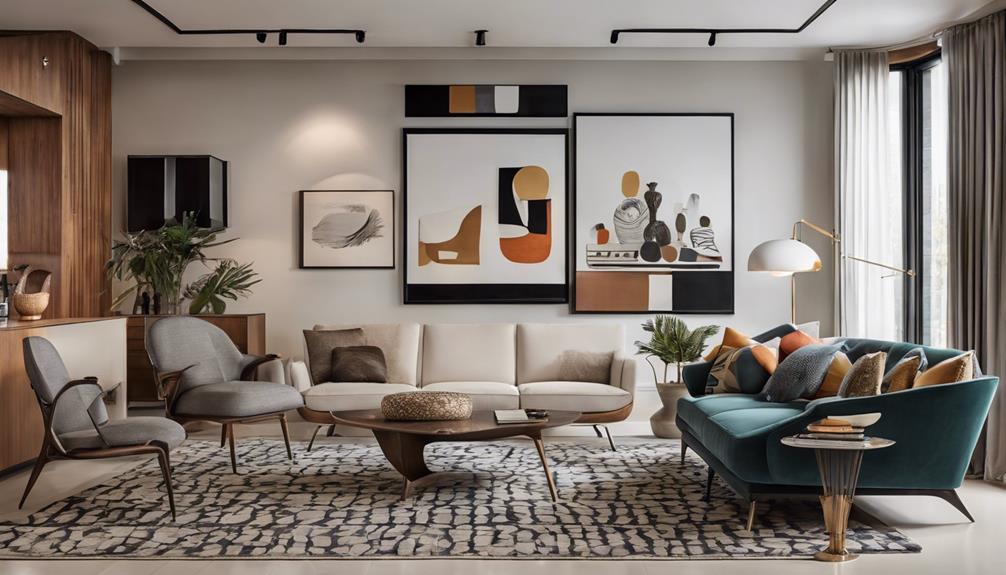
When it comes to distinguishing between modern and mid-century modern design, the differences go beyond mere aesthetics. While both styles share some similarities, such as clean lines and functionality, a closer examination reveals unique characteristics that set them apart in the world of interior design.
Understanding these nuances can help us appreciate the evolution of design trends and make informed choices when it comes to decorating our living spaces.
Key Takeaways
- Modern design emphasizes clean lines and minimalism with natural materials.
- Mid-century modern design focuses on functionality, sleekness, and bold furniture shapes.
- Modern design leans towards open spaces and large windows for light.
- Mid-century modern design incorporates warm woods, retro flair, and geometric patterns.
Origins of Modern and Mid-Century Design
Modern design emerged in the 1920s as a response to the ornate and intricate styles of traditional design. It was heavily influenced by the Bauhaus movement, which emphasized functionality and simplicity in design. The Bauhaus movement, originating in Germany, sought to combine fine arts with crafts, embracing new materials and methods of production.
Mid-century modern design evolved post-World War II, reflecting a shift towards more casual and informal living styles. This design movement integrated aspects of nature and the outdoors, blurring the lines between indoor and outdoor spaces. Mid-century modern design is characterized by flat planes, large windows, and a seamless flow between interior and exterior environments. Unlike modern design, mid-century modern design values function over form, often incorporating retro decorative accents to create a sense of nostalgia and warmth in living spaces.
Key Features of Modern Design

With a focus on sleek lines, minimalism, and functionality, the key features of modern design embody a timeless elegance that integrates natural materials like wood and metal.
- Clean Lines: Modern design is characterized by crisp, straight lines that create a sense of simplicity and sophistication in the space.
- Minimalism: Embracing the 'less is more' philosophy, modern design avoids clutter and excess ornamentation, focusing on essential elements that enhance the overall aesthetic.
- Natural Materials: Utilizing materials such as wood and metal, modern design brings a touch of nature indoors, adding warmth and texture to the clean and contemporary spaces.
In addition to these key features, modern design often includes open floor plans that promote a sense of airiness and fluidity throughout the area. By incorporating large windows to invite natural light and emphasizing spaciousness, modern design creates environments that are both functional and visually appealing.
Key Features of Mid-Century Modern Design
Moving from the key features of modern design, we now shift our focus to exploring the distinctive elements that define mid-century modern design. Mid-century modern design emerged post-World War II, focusing on functionality and sleekness. This style incorporates a mix of materials such as wood, metal, and glass, creating a retro yet timeless look. Clean lines, organic shapes, and pops of bold colors are key characteristics, contributing to a vibrant and unique aesthetic.
In terms of furniture, mid-century modern design often features leggy, tapered pieces made from warm-toned woods and adorned with geometric patterns. This design ethos values simplicity, functionality, and a seamless integration with nature. It's a popular choice for both residential and commercial spaces due to its timeless appeal and versatility.
When comparing Mid-Century Modern vs. modern styles, the former stands out for its attention to detail, retro charm, and enduring popularity in the world of interior design.
Incorporating Modern Design in Home Decor

When embracing contemporary design principles in home decor, one can achieve a sense of sophistication and functionality through clean lines and natural materials. Modern designs emphasize minimalism and symmetry, creating a sleek and uncluttered space that feels open and inviting.
To incorporate modern design into your home decor effectively, consider the following:
- Choose Furniture Pieces Wisely: Opt for furniture with clean lines and simple forms to maintain the minimalist aesthetic of modern design.
- Incorporate Decorative Accents: Select decorative accents that complement the modern style, such as geometric patterns, metal finishes, or abstract artwork.
- Focus on Interior Design: Pay attention to the layout and arrangement of your space to ensure a harmonious flow and balance that reflects modern design principles.
Incorporating Mid-Century Modern Design in Home Decor
To seamlessly blend modern design principles with a touch of retro flair, consider incorporating Mid-Century Modern elements into your home decor. Originating in the mid-20th century, this design style focuses on merging indoor and outdoor living spaces, characterized by flat planes, large glass windows, and organic shapes that emphasize simplicity, functionality, and a connection to the outdoors. When it comes to furniture, mid-century modern design features elongated, bold shapes, leggy, tapered frames, and warm-toned woods that create a nostalgic retro feel.
For those looking to incorporate mid-century modern design into their home decor, decorating tips include using floor pillows, plants, low furniture, and arched lighting, while embracing abstract, atomic, and geometric patterns. Mixing mid-century modern with bohemian styles can involve combining raw or mixed wood with bold colors, eye-catching patterns, layered textures, and global accents for a unique and eclectic look that marries the past with the present in a stylish and innovative manner.
Frequently Asked Questions
How Is Mid-Century Modern Different From Modern?
We find that Mid-century modern design stands out from modern design due to its retro vibe with colorful accents and flashy decor, while modern design focuses on clean lines, minimalism, and natural materials.
Mid-century modern embraces boldness and vibrancy in decor choices, whereas modern design opts for a more understated and simplistic approach.
These distinctions allow individuals to choose between the two styles based on their preference for color schemes and overall aesthetic.
Can I Mix Modern and Mid-Century Modern?
Absolutely! Mixing modern and mid-century modern design can result in a stunning fusion of styles. By combining sleek lines and minimalism with retro elements and pops of color, you can create a unique and eclectic look in your space.
Experimenting with blending different furniture pieces, colors, and textures allows for a personalized and dynamic interior design that reflects individual style preferences. Incorporating both styles can lead to a harmonious and balanced aesthetic.
What Style Is Closest to Mid-Century Modern?
Scandinavian design closely aligns with Mid-Century Modern, emphasizing geometric shapes, tailored upholstery, and light-colored woods. This style captures the essence of simplicity and functionality, reflecting a timeless aesthetic that resonates with Mid-Century Modern principles.
How Do I Know if My Furniture Is Mcm?
When determining if furniture is mid-century modern, look for the following features:
- Clean lines and organic curves
- Materials like teak or rosewood
- Tapered legs, sleek silhouettes, and minimalist designs
- Warm earthy tones or bold hues in the color palette
- Unique decorative accents and retro patterns
- A focus on functionality
These elements can help us recognize if a piece fits the mid-century modern style.
Conclusion
In conclusion, the differences between modern and mid-century modern design are rooted in their historical origins and distinct characteristics.
While modern design emphasizes functionality and industrial materials, mid-century modern design focuses on simplicity, nature, and a retro aesthetic.
Incorporating elements of both styles in home decor can create a unique and stylish living space that blends the best of both worlds.
Stay tuned for more tips on how to incorporate these design styles into your own home!
- About the Author
- Latest Posts
Introducing Ron, the home decor aficionado at ByRetreat, whose passion for creating beautiful and inviting spaces is at the heart of his work. With his deep knowledge of home decor and his innate sense of style, Ron brings a wealth of expertise and a keen eye for detail to the ByRetreat team.
Ron’s love for home decor goes beyond aesthetics; he understands that our surroundings play a significant role in our overall well-being and productivity. With this in mind, Ron is dedicated to transforming remote workspaces into havens of comfort, functionality, and beauty.
Architecture Home Styles
10 Surprising Reasons People Keep Their Houses Dark
Yearning for a deeper understanding of why some choose shadows over light in their homes? Discover the unexpected motivations behind this intriguing preference.

Have you ever wondered why some people prefer to live in what seems like perpetual twilight within their homes? It's a curious phenomenon that sparks intrigue and prompts us to ponder the unexpected motivations behind this choice.
As we explore the multifaceted reasons individuals keep their living spaces dimly lit, we uncover a myriad of surprising factors that go beyond mere lighting preferences. From psychological comfort to unexpected health benefits, the desire for darker surroundings reveals a complex interplay of personal inclinations and practical considerations that might just change your perspective on this seemingly simple decision.
Key Takeaways
- Dark rooms foster psychological comfort and tranquility amidst chaos and overstimulation.
- Opting for natural light in dark spaces conserves energy and reduces electricity bills.
- Dark interiors provide privacy, security, and solace for those seeking refuge from unwanted eyes.
- Creating a stylish and inviting atmosphere, dark color schemes enhance aesthetics and promote better sleep quality.
Psychological Comfort
Amidst the hustle and bustle of modern life, many individuals find solace and tranquility in the embrace of dark spaces, seeking emotional comfort and a retreat from the relentless demands of the outside world. When we keep the blinds open, allowing just a hint of natural light to filter through, we create a cozy sanctuary where we can truly unwind. By incorporating natural materials like wood and stone into our dark interiors, we connect with the earth's grounding energy, fostering a sense of peace within ourselves.
Being able to see without the harsh glare of artificial lights can be a liberating experience, allowing us to relax and rejuvenate. The subtle play of light and shadows in a dark room creates a soothing atmosphere that promotes psychological comfort. It's in these moments of gentle darkness that we find a refuge from the overstimulation of the day, embracing a more serene state of mind. Dark spaces offer a canvas for our thoughts to wander freely, unencumbered by the distractions of a brightly lit world.
Energy Conservation
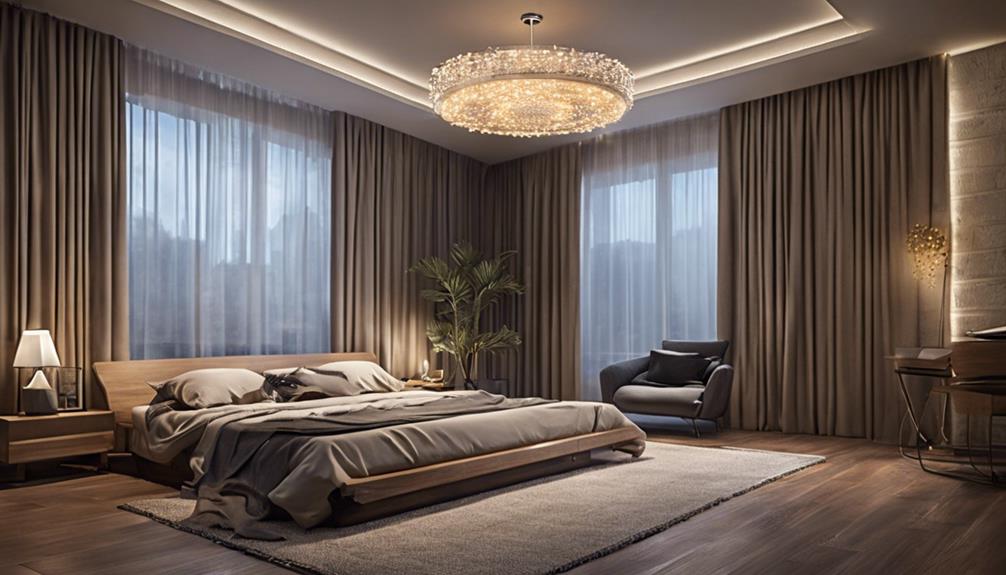
In the realm of household management, a significant motivation for maintaining dimly lit interiors is the emphasis on energy conservation. By reducing lighting usage, we not only lower electricity bills but also decrease our carbon footprint. Here are some key points to consider:
- Using natural light: Opting for natural light during the day instead of relying solely on artificial lighting is a sustainable practice that can significantly reduce energy consumption.
- Opting for energy-efficient lighting: Choosing energy-efficient options like LED bulbs is a smart move for those looking to conserve energy and cut costs in the long run.
- Implementing smart lighting systems: Installing smart lighting systems that adjust brightness based on natural light levels not only enhances convenience but also contributes to energy conservation efforts.
- Keeping curtains drawn: Drawing curtains during the day to let in natural light while minimizing heat gain can help regulate indoor temperatures and reduce the need for artificial lighting.
Privacy Concerns
With a focus on conserving energy through lighting adjustments, the conversation seamlessly shifts to the realm of privacy concerns influencing individuals to keep their houses dark. Fear of break-ins and intrusions can drive us to opt for darker living spaces, seeking that added layer of privacy when we come home. It's not just about energy savings; privacy concerns, such as avoiding peeping Toms or unwanted eyes, play a significant role in our decision to keep curtains drawn and lights low.
For some of us who've endured past traumatic experiences involving privacy violations, darker environments may provide a sense of security and comfort. Balancing the need for natural light with privacy can be achieved by using privacy shears during the day, allowing us to control the level of exposure while maintaining our desired sense of seclusion.
Ultimately, personal preference for privacy is a compelling factor in choosing to live in darker settings, where we feel safe and shielded from external intrusions.
Aesthetic Appeal
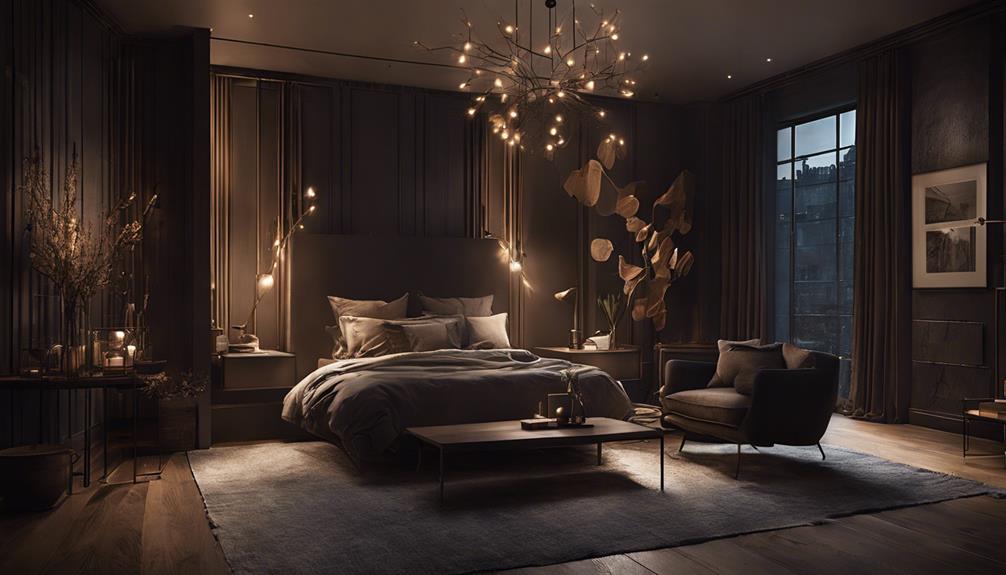
Exploring the captivating allure of dark interiors reveals a realm where visual aesthetics intertwine with a sense of cozy sophistication and elegance. Dark rooms possess an undeniable charm that goes beyond mere color schemes; they offer a canvas for creativity and individuality. Here's why dark interiors can be so appealing:
- Dramatic Contrast: Dark color schemes allow for striking contrasts when paired with light accents, creating a visually dynamic atmosphere that captivates the eye.
- Sophisticated Elegance: The use of dark hues can evoke a feeling of luxury and refinement, elevating the overall ambiance of a space.
- Cozy Atmosphere: Dark rooms have a unique ability to create a warm and inviting atmosphere, perfect for unwinding after a long day.
- Enhanced Architectural Features: By playing with light and shadow, dark interiors can accentuate specific architectural elements, adding depth and character to a room.
Incorporating these elements into interior design can transform a space into a haven of style and sophistication, appealing to those who seek liberation through unique and aesthetically pleasing environments.
Better Sleep Quality
Delving into the realm of dark interiors unveils a key element crucial for enhancing sleep quality: the absence of bright light. Exposure to bright light before bedtime can disrupt our body's natural sleep-wake cycle, impacting the production of melatonin, which is essential for quality sleep. By creating a dark environment, we signal our brains to produce melatonin, helping us fall asleep faster and enjoy a more restful slumber.
Blocking out light sources in the bedroom can promote deeper sleep, leading to better overall sleep quality and duration. Studies have shown that dark rooms can significantly improve our sleep quality, allowing us to wake up feeling more refreshed and rejuvenated. Whether it's investing in blackout curtains, switching off bright overhead lights, or simply embracing the tranquility of darkness, prioritizing a dark environment can be a game-changer for those seeking liberation from restless nights and aiming for a peaceful slumber.
Protecting Artwork

We all know how sunlight can be a double-edged sword when it comes to preserving our beloved artwork. Those vibrant colors we cherish can fade away in the harsh light.
Artwork Light Sensitivity
To safeguard delicate artwork from the damaging effects of sunlight, many homeowners prefer to keep their houses dimly lit. This practice helps prevent colors from fading and maintains the quality of paintings, photographs, and other valuable pieces. Art collectors often opt for controlled lighting to preserve the integrity of their collections. By keeping rooms dark, the vibrancy and longevity of the artwork on display are prolonged, ensuring that each piece remains as captivating as the day it was acquired.
- Dim lighting protects artwork from fading
- Controlled lighting preserves the integrity of valuable pieces
- Dark rooms maintain the vibrancy of displayed artwork
- Prevents sunlight damage to paintings, photographs, and other pieces
UV Damage Prevention
Dim lighting in homes plays a crucial role in safeguarding valuable artwork by significantly reducing the risk of UV damage. UV radiation can cause colors to fade and materials to deteriorate over time, making darkness a protective measure. Art collectors and museums often keep their spaces dark to preserve the integrity of paintings, sculptures, and other art pieces. Direct sunlight can be particularly damaging to artwork, prompting the need for controlled lighting environments. Maintaining a dark setting can prolong the lifespan and beauty of art collections by minimizing UV-related risks.
| UV Damage Prevention | Importance | Effects |
|---|---|---|
| Reduced Exposure | Protects Artwork | Prevents Fading of Colors |
| Controlled Lighting | Preserves Integrity | Minimizes Deterioration of Materials |
| Art Collector Choice | Extends Art Lifespan | Safeguards Against UV Risks |
Color Preservation Techniques
Protecting artwork's vibrant colors requires implementing effective color preservation techniques in dark environments to shield against UV damage and maintain long-lasting artistic integrity. To keep your artwork looking its best, consider the following tips:
- Utilize UV-Filtering Glass: Invest in UV-filtering glass to protect artwork from harmful sunlight exposure.
- Rotate Artwork: Regularly rotate your art pieces to ensure even exposure and prevent color fading in specific areas.
- Control Humidity Levels: Maintain stable humidity levels to prevent moisture damage that can affect color vibrancy.
- Use Conservation-Grade Materials: Opt for conservation-grade materials when framing artwork to provide an extra layer of protection against color deterioration.
Minimizing Glare
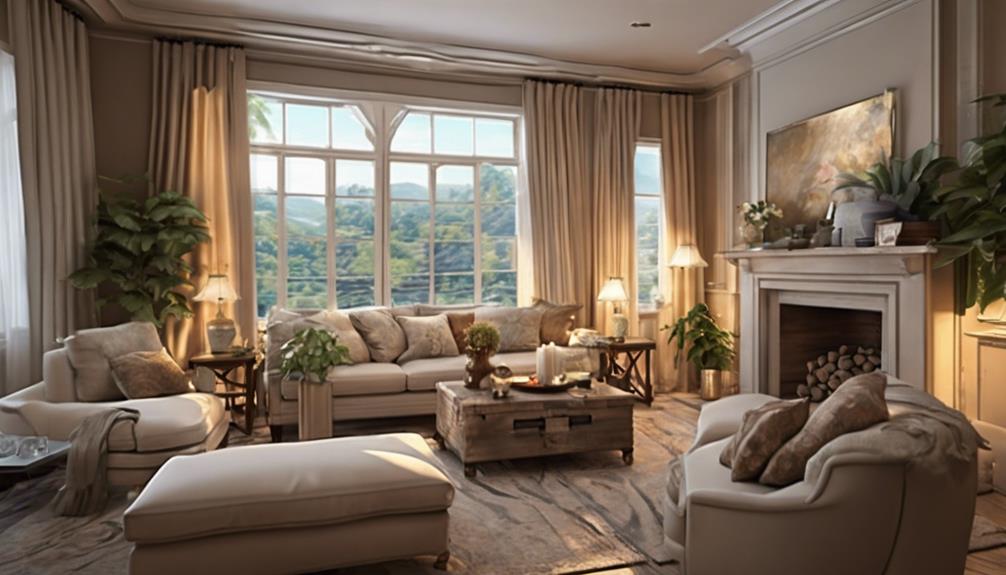
When seeking to create a comfortable and visually soothing home environment, minimizing glare becomes a crucial consideration. Glare from bright sunlight can cause eye strain and discomfort, making it essential to keep the house dark to reduce these effects. Homes with large windows or abundant natural light are especially prone to glare issues, highlighting the importance of managing light levels effectively. By embracing dark interiors, harsh reflections can be minimized, creating a more pleasant ambiance while improving visibility within the space. Dark rooms not only enhance the overall aesthetic but also help individuals focus on tasks without being distracted by excessive lighting.
| Benefits of Minimizing Glare |
|---|
| Reduces eye strain |
| Enhances visual comfort |
| Improves visibility |
| Creates a soothing ambiance |
| Minimizes distractions |
Cooling Effects
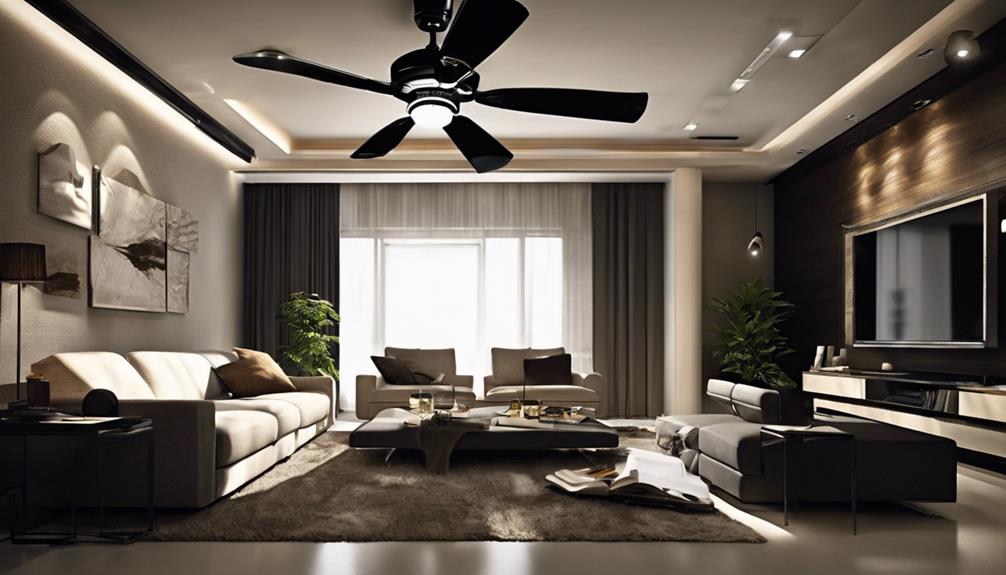
Staying cool in our homes can be effortlessly achieved by incorporating dark interiors that not only enhance aesthetic appeal but also help in reducing the temperature through various design elements. Dark color schemes play a crucial role in creating a comfortable environment during hot weather. Here are some ways dark interiors contribute to cooling effects:
- Less Sunlight Absorption: Dark interiors absorb less sunlight, preventing excessive heat buildup.
- Heat Blockage: Choosing dark curtains or blinds can effectively block out excess heat from entering the house.
- Reduced Light Reflection: Dark walls and decor reduce the reflection of light, helping to keep rooms cooler.
- Cooling Elements: Opting for dark furniture and flooring adds to the overall cooling effect in the house.
Security Purposes

Ensuring the safety of our homes, some individuals choose to keep their houses dark for security purposes. By maintaining a dimly lit exterior, they aim to deter potential intruders and protect their property. Dark houses can give the illusion that nobody is home, reducing the risk of break-ins. Drawing curtains further prevents outsiders from peeking in and spotting valuable items within. This sense of privacy also conceals the interior layout of the home from prying eyes, adding an extra layer of security.
To strike a balance between privacy and visibility, security experts recommend thoughtful lighting choices that enhance safety without compromising on comfort. Below is a table summarizing some key considerations when using darkness as a security measure:
| Security Lighting Tips | Description | Benefits |
|---|---|---|
| Use motion-sensor lights | Activated by movement, these lights startle intruders and alert homeowners to potential threats. | Enhanced security |
| Install timer-controlled lights | Simulate occupancy by setting lights to turn on and off at specific times, giving the appearance of someone being home. | Deterrence of burglars |
| Opt for smart lighting systems | Allow remote control of lights through smartphones, enabling homeowners to adjust settings from anywhere. | Convenience and customization of security measures |
Enhancing Mood
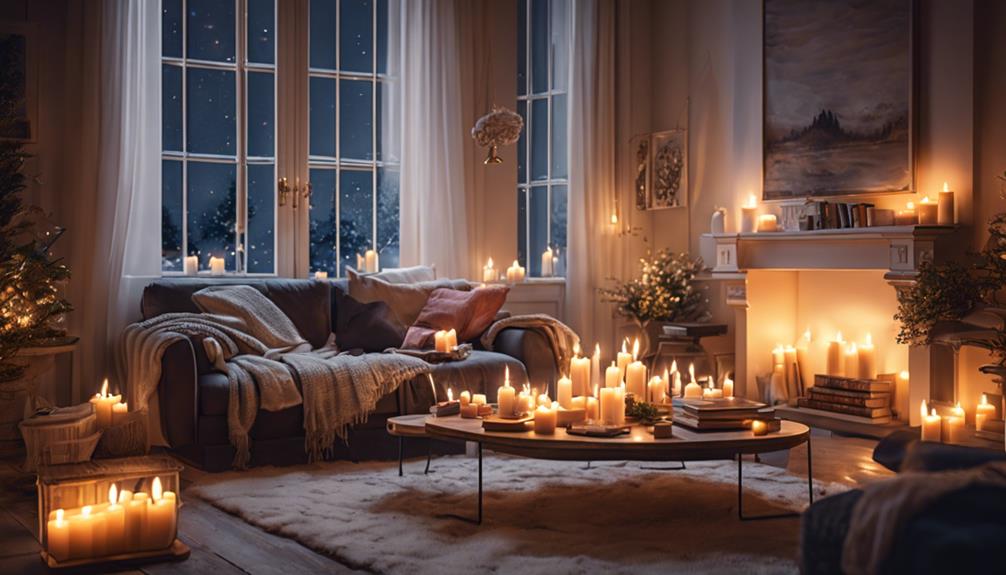
Enhancing the ambiance of a space through dim lighting can significantly impact our mood and emotional well-being. While some may find it unconventional, there are surprising reasons individuals choose to keep their houses dark. Here are a few insights into how dim lighting can enhance mood:
- Comfort and Relaxation: Dark environments have the power to evoke feelings of comfort and relaxation, creating a safe haven within the home.
- Solace and Tranquility: For many, dimly lit spaces offer solace and tranquility, contributing to an improved emotional state and overall well-being.
- Coziness and Security: The coziness and security that dark interiors provide can positively influence mood, making one feel more at ease and content.
- Soothing Ambiance: Dark colors and dim lighting can work together to create a soothing ambiance, promoting a sense of calmness and serenity in the home.
These factors illustrate how personal preferences for low light levels can impact our emotional state in a positive way, allowing us to curate spaces that resonate with our inner selves.
Frequently Asked Questions
Why Do People Keep Their Houses Dark?
We keep our houses dark for various reasons. Light sensitivity, privacy concerns, and a desire for coziness all play a role. Dark environments can provide comfort and security, especially for those dealing with depression.
However, transitioning to a brighter setting could boost mood and well-being. Our living spaces reflect our needs and preferences, whether it's about creating a sanctuary or maintaining a sense of safety and calm.
Why Do I Like My House to Be Dark?
We like our house dark for various reasons. It's a sanctuary, offering comfort and peace. Dark rooms create a cozy atmosphere that helps us unwind and relax.
Our preference for dim lighting is also tied to emotional well-being. Solitude and tranquility are essential for us to recharge and find serenity. The soothing effect of darkness on our mood is undeniable, making our home a haven of calm and quiet.
Why Do Some People Prefer Dark Rooms?
We prefer dark rooms for various reasons. Some find solace in darkness, offering comfort amidst depression. Others seek privacy by keeping curtains drawn, creating a sense of seclusion.
Fear of break-ins drives some to avoid drawing attention to valuables by maintaining a dark home. Migraine sufferers also appreciate the relief from bright lights.
These diverse preferences show how darkness can cater to personal needs and well-being.
Why Do I Prefer Living in the Dark?
We choose to dwell in darkness for reasons that bring us comfort and peace. The dimly lit spaces we inhabit offer solace and relief from the harshness of bright light. Our preference for the shadows stems from a deep desire for emotional tranquility and well-being.
In the dark, we find a haven where our minds can rest and our spirits can thrive. It's in the shadows that we find our true light.
Conclusion
In conclusion, it's fascinating to consider the myriad reasons why people choose to keep their houses dark. Did you know that according to a recent survey, 1 in 5 individuals prefer a dimly lit living space to promote relaxation and create a cozy ambiance?
From psychological comfort to energy conservation, the decision to maintain a dark home is as diverse as the individuals who make it.
Embrace the beauty of darkness and discover the surprising benefits it can offer.
- About the Author
- Latest Posts
Introducing Ron, the home decor aficionado at ByRetreat, whose passion for creating beautiful and inviting spaces is at the heart of his work. With his deep knowledge of home decor and his innate sense of style, Ron brings a wealth of expertise and a keen eye for detail to the ByRetreat team.
Ron’s love for home decor goes beyond aesthetics; he understands that our surroundings play a significant role in our overall well-being and productivity. With this in mind, Ron is dedicated to transforming remote workspaces into havens of comfort, functionality, and beauty.
-

 Vetted3 weeks ago
Vetted3 weeks ago15 Best Contact Paper for Kitchen Cabinets to Elevate Your Home Decor
-

 Vetted1 week ago
Vetted1 week ago15 Best Poe Cameras for Home Security – Reviews & Buying Guide
-

 Vetted4 weeks ago
Vetted4 weeks ago15 Best Leather Restorer Products to Revive Your Furniture and Accessories
-

 Vetted3 weeks ago
Vetted3 weeks ago15 Best Drain Snakes to Unclog Your Pipes Like a Pro
-

 Beginners Guides4 hours ago
Beginners Guides4 hours agoI Inhaled Vinegar Fumes
-

 Beginners Guides2 weeks ago
Beginners Guides2 weeks agoSwinger Porch Light Color
-

 Vetted3 weeks ago
Vetted3 weeks ago14 Best Stationery Brands for Your Next Writing Adventure
-

 Mardi Gras Decoration3 weeks ago
Mardi Gras Decoration3 weeks agoWhy Does Hobby Lobby Not Do Mardi Gras?





















